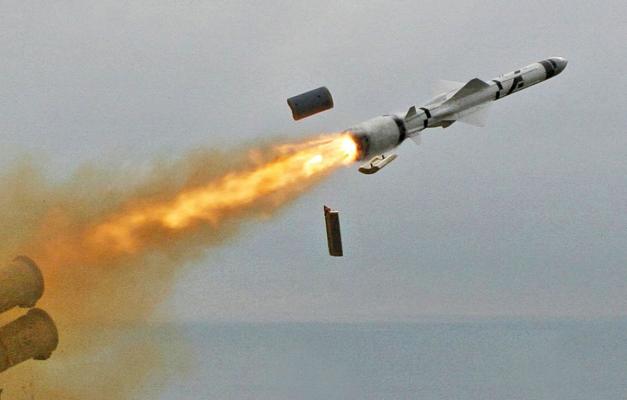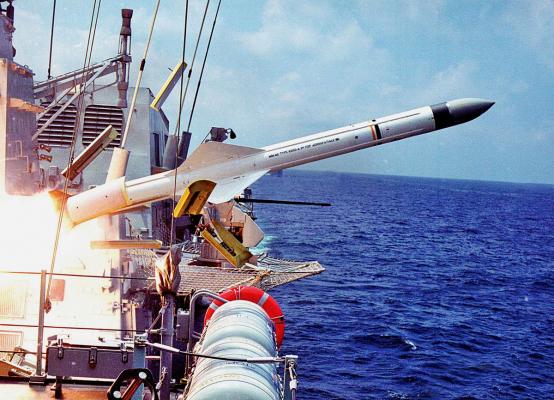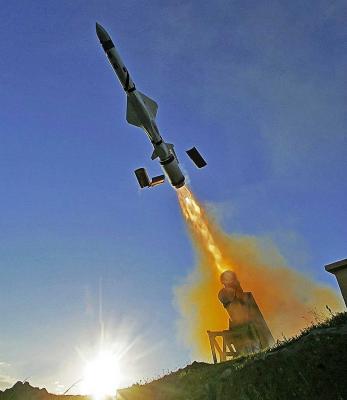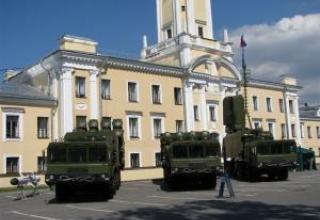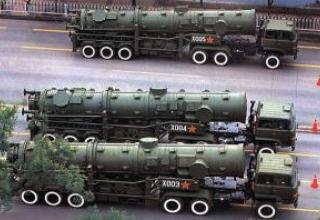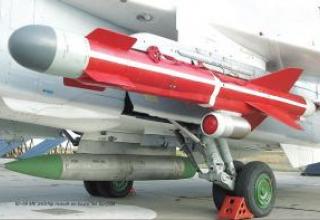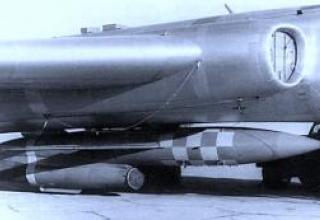Anti-ship missile (SSC) Exocet is designed to engage surface ships and transport vessels of the enemy from shock groups or the following alone day and night, in any weather conditions, with intense interference and fire counteraction of the enemy. May be used alone or in a volley.
The main developer of the missile is the French company Aerospatiale (in the creation of the missile and missile system participated firms of Germany and Great Britain). The official announcement of the beginning of the development of the Exocet anti-ship missile appeared in August 1968. Tests of the first Exocet missile, later designated MM-38, began in 1973. The final stage of the MM-38 flight test program was a month or so of firing, involving the English light cruiser Norfolk type County and four ships of the German and Greek Navy. All 10 missiles launched by them hit their targets. During the tests, two missiles fired in a single salvo hit a target 4m wide and 1m high at the same time. During the missile test cycle conducted in 1974, the fleets of France, England, Germany, Greece and Peru made 33 launches, 28 of which (85%) were successful. The Exocet MM-38 complex was adopted for service with the French Navy in 1975.
The Exocet anti-ship missile became most famous as a result of successful combat application during the Falkland Islands War (1982) between Great Britain and Argentina.
The Exocet is designed and manufactured in several variants:
- MM-38 is a ship-to-ship class missile;
- AM-39 - air-ship class missile;
- MM-39 - ship-to-ship class missile, shore-to-ship;
- SM-39, ship-to-ship class missile; AM-39, ship-to-ship class;
- MM-40 - ship-to-ship class, shore-to-ship missile.
Over the long years of service, all versions of the missile have been repeatedly upgraded. In 1993, the missile's control and homing system was converted to a new element base and digital methods of information processing. This version, designated Exocet block II, is equipped with a new ADAC Mk II CNS and has enhanced capabilities to overcome missile defense.
The last variant of the MM-40 block III missile is equipped with an improved marching engine, programmable adaptive homing head, which provides a selective choice of targets and work under the conditions of multiple firing, which involves the flight of several missiles to the target from one direction. The MM-40 Block III has been specially modified for use with coastal targets. In order to increase the range of fire (up to 180 km), a variant of equipping the Exocet Block III missile with a Microturbo TRI-40 turbojet engine has been developed (see diagram).
Different versions of the missile are in service with the Navy of more than 18 countries.
Composition:
The rockets of Exocet family (see the scheme) are made according to the usual aerodynamic scheme with a cross wing installed in the middle part of the hull and tail rudders.
All versions of the Exocet rocket are equipped with an inertial control system, a radio altimeter and an active radar pulsed homing head (ARGSN). The inertial platform has two gyroscopes and three accelerometers. The MM-39 ARGSN with horizontal stabilization of the directional pattern weighing about 30 kg operates at a frequency of 8-10 GHz. The ARGSN is capable of detecting a "frigate" type ship with an effective scattering surface of about 100 square meters at a range of up to 24 km. The antenna searches for targets in a sector of ±16° on azimuth and ±10° on the angle of place. Homing heads of all variants of the missile can capture a target (including small-size), having a speed of up to 40 knots, regardless of the duration of autonomous flight and accuracy of preliminary target designation data.
Shrapnel-phase warhead (BC) with a large number of fragments, unified for all versions of the rocket "Exocet", has contact and non-contact fuses. The mass of the BC explosive is 165 kg. The highest efficiency of a combat unit is achieved at angles of encounter with a target of about 70°.
The MM-39 solid propellant marching engine is made of aluminum alloy. It has an internal heat protection coating and is equipped with an EOLE V end burning solid fuel charge. The engine run time is about 110s. The engine is started by means of pyrocharges. The starting engine is also solid fuel and differs from the marching engine by its lower weight. Start engine running time is 2 s.
The Vega fire detection and control system, developed by Thomson-CSF, is used to detect, identify and track the target, as well as to guide the missile during the initial flight. Designed for small and medium displacement ships, it consists of a Triton detection and target designation radar and a Pollux fire control radar. The former operates in the "C" range at ranges up to 30-45 km (depending on the height of the antenna station). During the preparation for launch, the rocket control system from the Vega system enters data on the vertical direction with an accuracy of ± 20', the carrier speed - ± 0.5 m/s, the azimuth of the target - ± 1', the distance to the target - ± 1.6%, and set one of the three modes of operation CNS. The rocket "Exocet" MM-40 coastal and ship-based can fire at targets outside the visible horizon. In this case, target designation is issued by aircraft and helicopters.
In preparation for rocket firing the ship makes a maneuver to ensure that the angle of the post-start missile rotation does not exceed ± 30 °. After leaving the container, the missile gains an average height of 30m (the highest - 75m). The range of the acceleration section is 4 km (see the trajectory diagram). The missile picks up speed and goes to the required height of 10-15 m, after which the marching engine is switched on, and the marching flight begins at a speed of 0.93M. The flight altitude is selected on the basis of the conditions, the implementation of which will eliminate the detection of the missile and provides a reliable capture of the CNS target at a safe distance for the missile. Controlled flight at an altitude of 10-15m is carried out inertial control system. The range of flight on the marching section is 20-22 km (when flying to the maximum range). At a distance of 12-15 km from a possible target position, the CLO is activated and the search begins. In order to capture a target with a displacement of about 250 t CWRSA requires about 2s. After the target is captured, the information about the target is processed, the flight path is corrected, and the parameters for attacking the target are set (in the tests the accuracy of the distance to the target was reached 0.5 m).
The missile's homing trajectory consists of two approach areas. In the first section, the missile is lowered to a height of 7.5 m, and in the following section - to 2-3 m (the value is determined by the sea state). In case of a strong wave (5-6 points), the missile can fly over the target, especially if the target (small ship) is between the ridges of the waves. In this case, a non-contact fuse is triggered, which detonates a combat unit above the deck of the target ship.
Coastal missile systems are equipped with twin or quadruple launchers. Each coastal defence battery consists of a mobile detection and target designation radar, three fire control stations, two launchers, transport and recharge vehicles and a repair shop (see photos 1, 2, 3, 4, 5, 6, 7, 8 and 9).
The Exocet MM-38 rocket shall be stored and transported in an airtight corrugated container from which it shall be launched. The container is made of a light alloy and hardened in accordance with the requirements of French and British naval standards. The length of the container - 5.4 m, width - 1.24 m, height - 1.13 m, weight - 1015 kg. Inside it, the missile is suspended on a horizontal guide rail. Term of storage of the rocket in the container without preventive inspections - one year, total storage period - 10 years. Standard missile launcher Exocet MM-38 is designed for four launch containers, which are docked using support frames with deck supports with a slope of 12°. The full set of standard launchers has a weight of 13500 kg, and the use of lightweight support frames on small ships can reduce the weight to 11200 kg.
The "Ì-39 Exocet missile (see photo) is in service with French Agosta diesel submarines and Rubin nuclear submarines. The layout scheme is the same as that of the MM-38, wing and rudder design is the same as that of the MM-40. In the torpedo vehicle, the missile is in a special capsule, which is ejected at launch by a gas generator. At a safe distance from the submarine is activated RDT capsule. Under water, the capsule is controlled by the rudders located in the engine's exhaust jet. The capsule passes the underwater section, comes out of the water and reaches a height of 30-50m, where the capsule is separated and the missile's marching engine is activated.
Aviation missile "Exocet" AM-39 (see photo) compared to the ship's smaller size, have improved flight characteristics, equipped with an anti-icing system. The marching engine is made of steel, which allowed not only to reduce dimensions, but also to apply more efficient fuel, thus increasing the range of fire (50 km when launching from a height of 300 m, 70 km when launching from a height of 10,000 m). The minimum launch height is 50m.
The MM-39 missile has a layout diagram of the AM-39 aircraft missile, but differs in its folding aerodynamic surfaces. In the project MM-39 used technical solutions rocket AM-39: increased scanning angle of the beam of GSN, increased by 10% range of target detection, increased pulse solid fuel, replacement of the aluminum engine housing on steel, changing the profile of the wing and rudder to use them at supersonic speeds. Replacement of the aluminum casing with the steel casing at the same missile diameter provided an increase in the weight of the fuel by reducing the thickness of the engine shell. The rocket is stored and launched from a cylindrical container made of fiberglass. The weight of the container is 670 kg. On the deck of the ship in the size of PU M-38 can accommodate twice as many launch containers of missiles MM-39. The use of these missiles in combination with a light fire control system allows you to place the missile system on ships of small displacement - patrol boats and small PDAs. Four-container launcher for Exocet MM-39 missiles has overall dimensions of 6.4x1.4x2.6 m.
The Exocet MM-40 missile (see layout diagram) is designed on the basis of the MM-39 and is intended to replace the MM-38 missile. It is equipped with a more advanced marching engine borrowed from the AM-39 aircraft missile. The solid fuel charge burning time is 220 seconds. Certain improvements have been made in the electronics that provide the work of the CNS, which has become programmable, adaptive, it is given the properties of selective choice of targets. The on-board control system has been improved: the carrier ship can fire at the target in a sector of ± 90° volleys at four missiles, which can simultaneously attack the target from different directions. The missile is launched automatically when the ship's heel is reduced to safe (17°). Fibreglass reinforced plastic containers are used to transport and launch the missile. The missile can be launched from shipborne and ground-based countersunk launchers (see diagram).
Characteristics:
| Range of fire, km: - MM-38 - MM-40 - MM-40 block 3 - SM-39 - AM-39 at launch from a height of 300m - AM-39 at launch from a height of 10,000m |
42 70 180 50 50 70 |
| Rocket speed maximum, km/h. | 1100 |
| Length, mm: - MM-38 - MM-40 - MM-40 block 2 - MM-40 block 3 - AM-39 |
5212 5646 5780 5780 4688 |
| The diameter of the rocket body, mm | 350 |
| Wingspan, mm | 1130 |
| Start weight, kg: - МM-38 - МM-40 - AM-39 |
735 875 660 |
| Weight of BC, kg: - МM-38 - МM-40 - AM-39 |
165 155 165 |
Testing:
The Exocet was first used on May 4, 1982 during the Falkland Islands War. On that day, an Argentine patrol aircraft "Neptune" at a distance of about 200 km found compounds of British ships. From Rio Grande Air Base, located at a distance of about 850 km, 5 attack aircraft "Super Etandar". Only 2 of them carried one anti-ship missile "Exocet" under the right console, and under the left console - a dumpable fuel tank with a capacity of 1100l. One aircraft with the same weapons was backed up, while the other two carried only the fuel tanks, acting as refuelers. Stormtroopers were going at an altitude of 50 m above sea level. At 46 km from the ships the pilots increased the altitude up to 150 m, made a short time, by 30 seconds, activation of on-board radars. On the screens of the indicators highlighted the marks of two targets: the destroyer URO "Sheffield" and frigate "Plymouth". The angle between the directions on them was 40 °. After entering data on each target at a distance of 37 km was launched two missiles "Exocet". At the time of launch, the onboard warning systems informed pilots about the illumination of the aircraft by the Plymouth frigate radar station. Sheffield's search radar was turned off to eliminate interference with Skynet's satellite communications system, through which negotiations were conducted with London. The aircraft immediately withdrew from the Sea Dart SAM system, which was armed with British Sheffield type destroyers. Active radar homing head of one of the missiles captured Sheffield at a distance of 12-15 km, the height of its flight dropped to 2-3 m. Visually, the missile was spotted only 6 seconds before hitting the ship. The rocket broke through the board 1.8m above the waterline, but inside the hull did not explode - did not trigger a contact delayed action fuse. The remnants of the rocket fuel ignited the electric cables and the paint. The compartment was quickly filled with toxic smoke and there was a real threat of missile and artillery ammunition explosions. After five hours of unsuccessful fight against the fire, the crew left the ship. The second missile from frigate "Plymouth" was discovered in advance - 40 seconds. A curtain of dipole reflectors created passive interference, which increased the missile in the wrong direction.
The largest ship, sunk by a guided missile after 1945, was the British air transport "Atlantic Conveyor", converted before the war from a civilian container ship. On 25 May, a pair of Super Etandar aircraft took off from the airbase in Rio Grande and headed north-east, then turned east, refueled from the C-130 aircraft and went south and then west to the aircraft carrier's manoeuvring area at an altitude of 30 m from the side with which the attack was least expected. Pointing the target was made from C-130 aircraft. On distance of 80 km from a prospective location of connection the Argentine pilots have found the aircraft carrier "Hermes" in an environment of other ships. Having launched the rocket from a distance of 48 km from the target, the aircraft immediately went towards the continent at extremely low altitude. At this time, the British from the ships and helicopters lifted into the air put obstacles - dipole reflectors. Disoriented by interference missiles captured the aircraft carrier "Atlantic Conveyor" located 6 km away and sunk it, along with 15 helicopters on board Wessex and Chinook.
On 30 May, the Super Etandar launched two Exocet rockets against the British aircraft carrier, the Invincible. Security ships and helicopters placed curtains in the form of clouds of dipole reflectors, as a result of which both missiles went off course and fell into the sea.
On May 17, 1987, an Iraqi Mirage fighter jet fired two Exocet missiles at the American frigate Stark. Both missiles hit the frigate, but only one exploded. However, the frigate was badly damaged. American experts noted that if it were in the stormy Atlantic and not in the calm in the Persian Gulf, the frigate would have inevitably sunk.
Sources:
- Б.И.Родионов, Н.Н.Новичков "Крылатые ракеты в морском бою", -М.: Военное издательство, 1987.-214с.
- Широкорад А.Б. "История авиационного вооружения", -Мн.: Харвест, 1999.-560с.
- Шунков В.Н. "Фрегаты и сторожевые корабли", -Мн.: Попурри, 2003.-640с.
